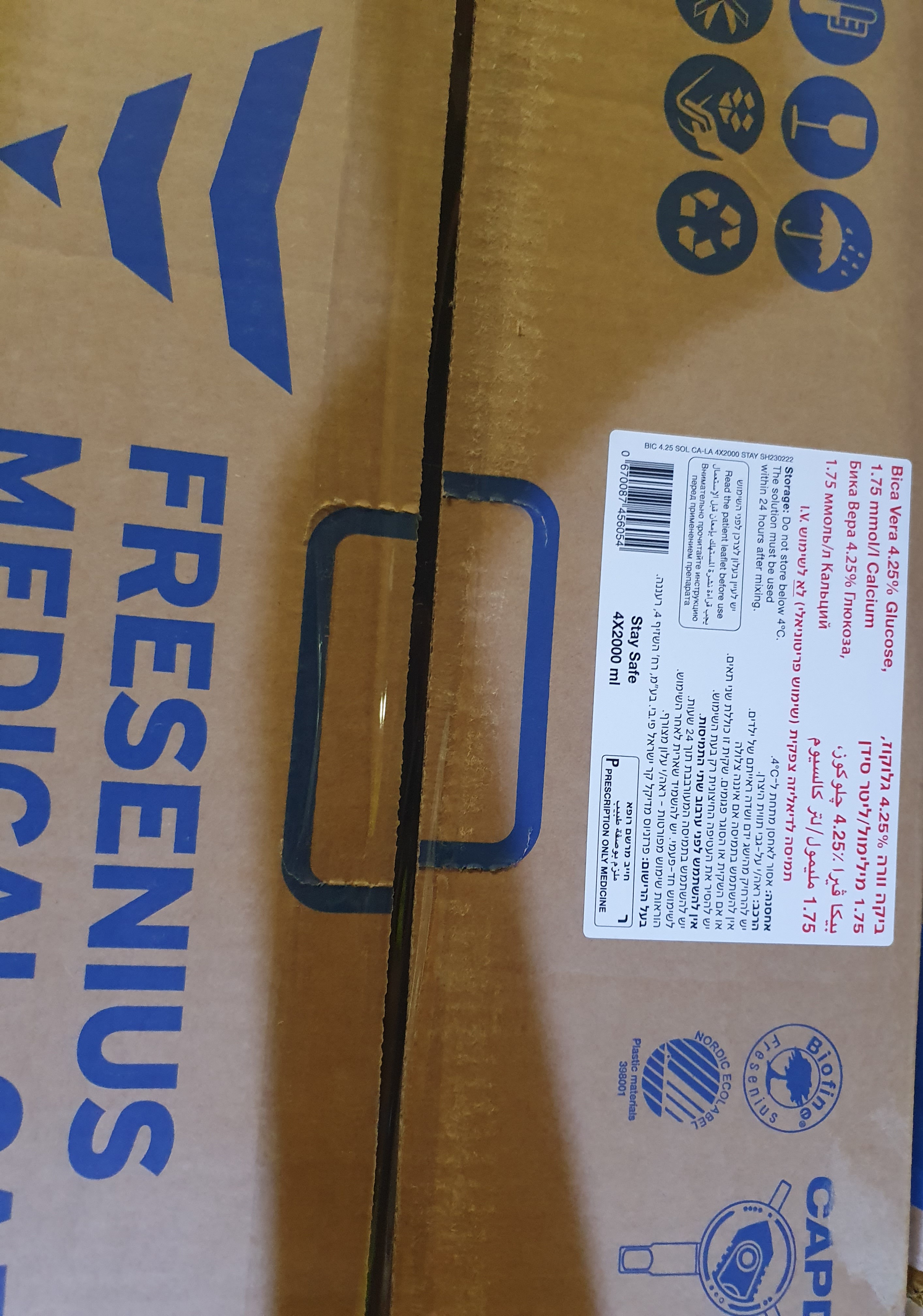Quest for the right Drug

ביקה וורה % 4.25 גלוקוז, 1.75 מילימול/ליטר סידן BICA VERA 4.25 % GLUCOSE, 1.75 MMOL/L CALCIUM (CALCIUM CHLORIDE DIHYDRATE, GLUCOSE AS MONOHYDRATE, GLUCOSE MONOHYDRATE, MAGNESIUM CHLORIDE HEXAHYDRATE, SODIUM CHLORIDE, SODIUM HYDROGEN CARBONATE)
תרופה במרשם
תרופה בסל
נרקוטיקה
ציטוטוקסיקה
צורת מתן:
דיאליזה לחלל הבטן : PERITONEAL DIALYSIS
צורת מינון:
תמיסה לדיאליזה פריטוניאלית : SOLUTION FOR PERITONEAL DIALYSIS
עלון לרופא
מינוניםPosology התוויות
Indications תופעות לוואי
Adverse reactions התוויות נגד
Contraindications אינטראקציות
Interactions מינון יתר
Overdose הריון/הנקה
Pregnancy & Lactation אוכלוסיות מיוחדות
Special populations תכונות פרמקולוגיות
Pharmacological properties מידע רוקחי
Pharmaceutical particulars אזהרת שימוש
Special Warning עלון לרופא
Physicians Leaflet
Adverse reactions : תופעות לוואי
4.8 Undesirable effects Bica Vera 4.25% Glucose, 1.75 mmol/l Calcium is an electrolyte solution which composition is similar to blood. In addition, the physiological buffer bicarbonate is used. Possible adverse reactions may result from the peritoneal dialysis itself or may be induced by the peritoneal dialysis solution. The adverse drug reactions are ranked under the headings of reporting frequency, using the following convention: Very common ≥1/10 Common ≥1/100 to <1/10 Uncommon ≥1/1,000 to <1/100 Rare ≥1/10,000 to <1/1,000 Very rare <1/10,000 not known cannot be estimated from the available data System Organ Class Preferred Term Frequency Metabolism and nutrition disorders Increased blood sugar levels common Hyperlipidaemia common Increase in body weight due to the continuous uptake of glucose from common the peritoneal dialysis solution Cardiac disorders Tachycardia uncommon Vascular disorders Hypotension uncommon Hypertension uncommon Respiratory, thoracic and mediastinal disorders Dyspnoea uncommon Renal and urinary disorders Electrolyte disturbances, e.g. Hypokalaemia very common Electrolyte disturbances, e.g. Hypercalcaemia uncommon General disorders and administration site conditions Dizziness uncommon Oedema uncommon Disturbances in hydration uncommon Potential adverse reactions of the treatment mode System Organ Class Preferred Term Frequency Infections and infestations Peritonitis very common Skin exit site and tunnel infections very common Respiratory, thoracic and mediastinal disorders Dyspnoea caused by the elevated diaphragm not known Gastrointestinal disorders Diarrhoea uncommon Constipation uncommon Hernia very common Abdominal distension and sensation of fullness common Encapsulating peritoneal sclerosis not known Injury, poisoning and procedural complications In- and outflow disturbances of the dialysis solution common Shoulder pain common Peritonitis is indicated by a cloudy effluent. Later abdominal pain, fever, and general malaise may develop or, in very rare cases, sepsis. The patient should seek medical advice immediately. The bag with the cloudy effluent should be closed with a sterile cap and assessed for microbiological contamination and white blood cell count. Skin exit site and tunnel infections are indicated by redness, oedema, exudations, crusts and pain at the catheter exit site. In case of skin exit site and tunnel infections the attending physician should be consulted as soon as possible. Disturbances in hydration is indicated by a rapid decrease (dehydration) or increase (overhydration) in body weight. Severe dehydration might occur when using solutions of higher glucose concentration. Reporting of suspected adverse reactions Reporting suspected adverse reactions after authorisation of the medicinal product is important. It allows continued monitoring of the benefit/risk balance of the medicinal product. Any suspected adverse events should be reported to the Ministry of Health according to the National Regulation by using an online form https://sideeffects.health.gov.il

שימוש לפי פנקס קופ''ח כללית 1994
לא צוין
תאריך הכללה מקורי בסל
לא צוין
הגבלות
לא צוין
מידע נוסף
